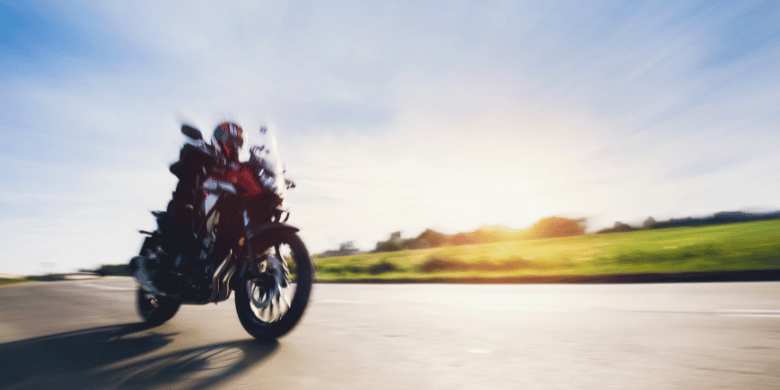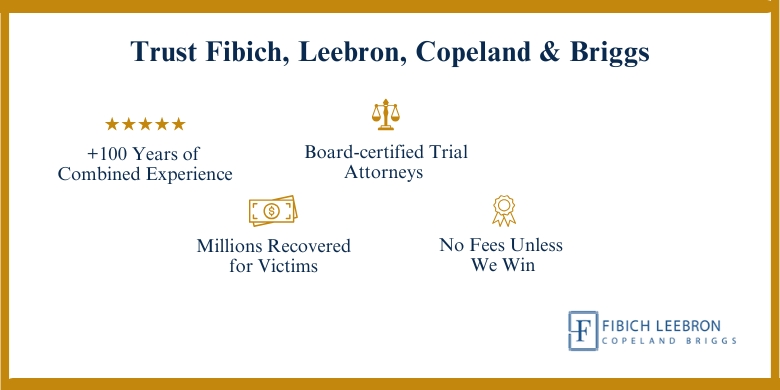The Dangers of Riding a Motorcycle in Houston: What Every Rider Needs to Know

Motorcyclists love the freedom of the open road and the thrill of experiencing the Bayou City from on top of a bike. They also know that this sense of thrill comes with a greater risk of being hurt in a crash. According to the National Highway Traffic Safety Administration (NHTSA), bikers are four times more likely to get injured and 22 times likelier to die in a motorcycle crash compared to standard vehicle drivers and passengers.
Understanding the critical hazards in and around Houston, along with how to anticipate and respond to them, can help you take proactive steps toward better motorcycle safety in Houston.
The Most Common Motorcycle Dangers in Houston
Houston is a big city with some specific hazards that motorcyclists should watch out for. Some of the biggest dangers of riding a motorcycle in Houston are:
- Heavy Traffic & Congestion – Houston is one of the most heavily trafficked cities in the country, with major highways and streets that are busy throughout the day and often clogged during rush hours. In congested traffic, motorcycles are harder for drivers to see, increasing the risk of accidents. Stop-and-go movement can also make it difficult for riders to maintain safe following distances, and sudden lane changes from impatient drivers can be deadly.
- Aggressive Drivers – Houston is infamous for its aggressive drivers, who engage in unsafe behaviors as speeding, tailgating, and abrupt lane changes. Frustration over dealing with Houston traffic can also lead to road rage. These actions put motorcyclists at risk, as they have less protection than those in cars.
- Road Construction & Potholes – Houston is always building, expanding, and repairing roads to address its booming population, which means motorcyclists must often navigate hazardous work zones. Uneven pavement, loose gravel, and unmarked detours can create dangerous riding conditions. Additionally, potholes and poorly maintained roads can cause riders to lose control of their bikes.
- Unpredictable Weather – There’s an old joke that if you don’t like the weather in Houston, just wait ten minutes—it’ll change. That joke takes on serious undertones for motorcyclists, as sudden rain showers, high winds, and flash flooding make the road even more dangerous to bikers. Wet roads reduce traction for motorcycles, making it easier to skid or hydroplane. Limited visibility due to fog or heavy rain can also increase the risk of collisions, as drivers may not be able to see smaller vehicles on the road.
- Drunk & Distracted Drivers – Drunk drivers are one of the biggest threats on the road, accounting for about a third of all traffic fatalities. Impaired drivers have slower reaction times and difficulty judging distances, making them more likely to crash into motorcycles. Distracted drivers pose a similar risk, as inattention has many of the same consequences on driving ability as intoxication.
Motorcycle Accidents in Houston: What the Numbers Say
Some 9,405 motorcyclists were involved in injury accidents across Texas in the most recent year with available data, according to motorcycle accident statistics from the Texas Department of Transportation (TxDOT). These crashes resulted in 599 deaths, 2,484 suspected serious injuries, 3,295 suspected minor injuries, and 1,456 possible injuries. Some 40 percent of the people killed in these accidents were not wearing helmets.
That same year, there were 394,351 motorcycles registered in Texas, according to the Insurance Institute for Highway Safety (IIHS). That means there was an injury or fatal accident rate of 29.4 per 100,000 registered motorcycles.
Motorcycle accidents accounted for about 4.8 percent of all traffic fatalities and suspected injuries in Texas. While TxDOT does not provide city-specific motorcycle accident numbers, applying the statewide rate to Houston suggests that there would have been around 1,525 motorcycle fatalities and suspected injuries in the city that year.
Per the IIHS, fatal motorcycle accidents peak between noon and 9 p.m., with the three-hour window of 3 p.m. to 6 p.m. accounting for nearly a quarter of all fatal accidents. About two-thirds of fatal motorcycle accidents take place in urban areas, with about two-thirds of these accidents taking place on non-interstate major roads.
Particularly dangerous roads for motorcyclists in Houston include:
- I-45
- I-10
- The 610 Loop
- US-59
How to Stay Safe on Houston’s Roads

For Houston motorcyclists, taking the following steps can reduce the chance of being in an accident and help protect you when you can’t avoid one:
- Wear Proper Gear – Wearing the right protective gear can mean the difference between minor and life-threatening injuries. A DOT-approved helmet is the most critical piece of gear, as head injuries are a leading cause of fatal motorcycle accidents. Additionally, consider wearing reinforced jackets, gloves, pants, and boots to protect against road rash and severe injuries.
- Stay Visible – One of the biggest dangers for motorcyclists is that other drivers often fail to see them. To improve visibility, wear bright-colored or reflective gear, keep headlights on at all times (even during the day), and avoid lingering in drivers’ blind spots. When changing lanes or making turns, signal early and make deliberate movements so that others can predict what you will do.
- Defensive Riding – Houston roads are unpredictable, and defensive riding is key to staying safe. Always assume that other drivers may not see you or may act unpredictably. Keep a safe following distance, be prepared for sudden stops, and avoid weaving between lanes to avoid motorcycle accident injuries. Anticipate hazards and always have an escape route in mind.
- Avoid Lane Splitting – Lane splitting refers to riding between lanes of slow-moving or stopped traffic. While proponents say it’s a good way to save time and reduce the likelihood of rear-end accidents in traffic, it is illegal in Texas. Cars may suddenly change lanes or open doors without noticing a motorcycle approaching. The risk of getting sideswiped or squeezed between vehicles is high.
- Be Extra Cautious at Intersections – Intersections are one of the most dangerous areas for motorcyclists. Left-turn accidents are common, as drivers have a hard time judging an oncoming motorcyclist’s speed. Slow down when you’re approaching an intersection, apply the brakes, and watch for signs that a vehicle might turn in front of you. Make eye contact with drivers when possible to ensure they see you before proceeding.
Legal Options After a Motorcycle Accident in Houston
Unfortunately, no amount of precaution or care on your part can eliminate the possibility of being in a motorcycle accident. However, you are not without legal options. Here’s what motorcycle accident victims need to know:
- What to Do After a Crash – Get medical help and attend all follow-up appointments. Report the accident to your insurer. Write down an account of the accident while your memory is still fresh. Gather supporting evidence like medical records, photos of the accident scene, pay stubs, and repair estimates.
- When to Contact a Houston Motorcycle Accident Lawyer – The sooner you get in touch with a motorcycle accident attorney, the better. Most offer free consultations so you can better understand your options without risk or obligation. Be sure to bring your evidence with you to this initial meeting.
- Possible Compensation – If someone else is to blame for the accident, they could owe you money for your medical bills, lost income, pain and suffering, property damage, and more.

Frequently Asked Questions
Here are the answers to some commonly asked questions about motorcycle accidents in Houston.
What Is the Most Common Cause of Motorcycle Accidents in Houston?
According to the Federal Highway Administration‘s (FHWA) motorcycle accident causation study, the leading causes of motorcycle accidents are failure perceptions by other drivers (30 percent), decision failures by other drivers (17 percent), decision failure by motorcyclists (14 percent), reaction failures by motorcyclists (12 percent), and perception failures by motorcyclists (11 percent).
Do I Have to Wear a Helmet in Texas?
Per Texas law, all motorcyclists under 21 must wear a helmet. Those 21 and older must wear a helmet unless they complete a motorcycle safety course or carry a health insurance policy providing at least $10,000 in medical benefits for injuries they suffer in a motorcycle accident while not wearing a helmet.
What Should I Do If I Get Into a Motorcycle Accident in Houston?
Once you’ve sought medical treatment and your condition has stabilized, contact a motorcycle accident lawyer. They can advise you on your rights and help you pursue maximum compensation for what you’ve suffered.
How Can I Avoid a Motorcycle Crash in Heavy Houston Traffic?
You can reduce your odds of being in a motorcycle crash in heavy Houston traffic by following the speed limit, driving defensively, and wearing high-visibility clothing.
Ride Smart, Stay Safe
By following these simple steps, you can reduce your chance of being in a serious motorcycle accident in Houston. Unfortunately, no precaution on your part can prevent other road users from driving carelessly or even recklessly and causing an accident. When that happens, reach out to the Houston motorcycle accident attorneys at Fibich, Leebron, Copeland & Briggs for help. There’s no charge for the consultation, and you won’t owe us anything unless we recover compensation for you.